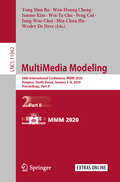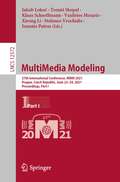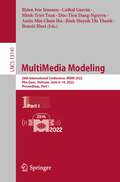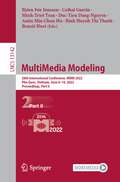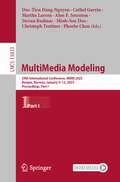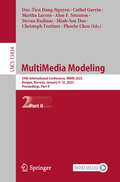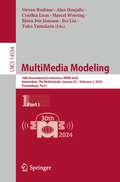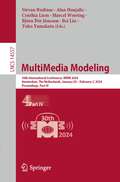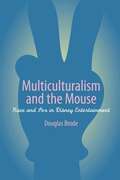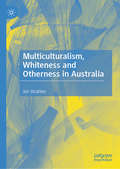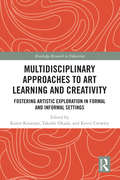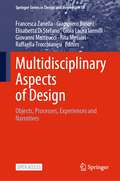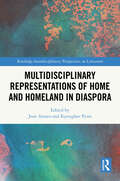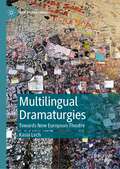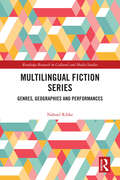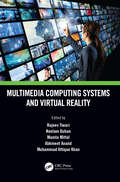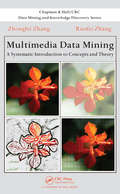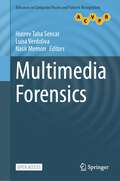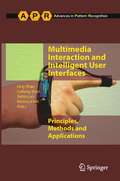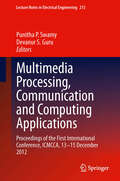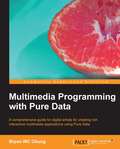- Table View
- List View
MultiMedia Modeling: 26th International Conference, MMM 2020, Daejeon, South Korea, January 5–8, 2020, Proceedings, Part II (Lecture Notes in Computer Science #11962)
by Jung-Woo Choi Junmo Kim Wen-Huang Cheng Wei-Ta Chu Peng Cui Min-Chun Hu Wesley De NeveThe two-volume set LNCS 11961 and 11962 constitutes the thoroughly refereed proceedings of the 25th International Conference on MultiMedia Modeling, MMM 2020, held in Daejeon, South Korea, in January 2020. Of the 171 submitted full research papers, 40 papers were selected for oral presentation and 46 for poster presentation; 28 special session papers were selected for oral presentation and 8 for poster presentation; in addition, 9 demonstration papers and 6 papers for the Video Browser Showdown 2020 were accepted. The papers of LNCS 11961 are organized in the following topical sections: audio and signal processing; coding and HVS; color processing and art; detection and classification; face; image processing; learning and knowledge representation; video processing; poster papers; the papers of LNCS 11962 are organized in the following topical sections: poster papers; AI-powered 3D vision; multimedia analytics: perspectives, tools and applications; multimedia datasets for repeatable experimentation; multi-modal affective computing of large-scale multimedia data; multimedia and multimodal analytics in the medical domain and pervasive environments; intelligent multimedia security; demo papers; and VBS papers.
MultiMedia Modeling: 27th International Conference, MMM 2021, Prague, Czech Republic, June 22–24, 2021, Proceedings, Part I (Lecture Notes in Computer Science #12572)
by Stefanos Vrochidis Klaus Schoeffmann Vasileios Mezaris Jakub Lokoč Tomáš Skopal Xirong Li Ioannis PatrasThe two-volume set LNCS 12572 and 1273 constitutes the thoroughly refereed proceedings of the 27th International Conference on MultiMedia Modeling, MMM 2021, held in Prague, Czech Republic, in June2021. Of the 211 submitted regular papers, 40 papers were selected for oral presentation and 33 for poster presentation; 16 special session papers were accepted as well as 2 papers for a demo presentation and 17 papers for participation at the Video Browser Showdown 2021. The papers cover topics such as: multimedia indexing; multimedia mining; multimedia abstraction and summarization; multimedia annotation, tagging and recommendation; multimodal analysis for retrieval applications; semantic analysis of multimedia and contextual data; multimedia fusion methods; multimedia hyperlinking; media content browsing and retrieval tools; media representation and algorithms; audio, image, video processing, coding and compression; multimedia sensors and interaction modes; multimedia privacy, security and content protection; multimedia standards and related issues; advances in multimedia networking and streaming; multimedia databases, content delivery and transport; wireless and mobile multimedia networking; multi-camera and multi-view systems; augmented and virtual reality, virtual environments; real-time and interactive multimedia applications; mobile multimedia applications; multimedia web applications; multimedia authoring and personalization; interactive multimedia and interfaces; sensor networks; social and educational multimedia applications; and emerging trends.
MultiMedia Modeling: 28th International Conference, MMM 2022, Phu Quoc, Vietnam, June 6–10, 2022, Proceedings, Part I (Lecture Notes in Computer Science #13141)
by Benoit Huet Cathal Gurrin Björn Þór Jónsson Minh-Triet Tran Duc-Tien Dang-Nguyen Anita Min-Chun Hu Binh Huynh Thi ThanhThe two-volume set LNCS 13141 and LNCS 13142 constitutes the proceedings of the 28th International Conference on MultiMedia Modeling, MMM 2022, which took place in Phu Quoc, Vietnam, during June 6–10, 2022.The 107 papers presented in these proceedings were carefully reviewed and selected from a total of 212 submissions. They focus on topics related to multimedia content analysis; multimedia signal processing and communications; and multimedia applications and services.
MultiMedia Modeling: 28th International Conference, MMM 2022, Phu Quoc, Vietnam, June 6–10, 2022, Proceedings, Part II (Lecture Notes in Computer Science #13142)
by Benoit Huet Cathal Gurrin Björn Þór Jónsson Minh-Triet Tran Duc-Tien Dang-Nguyen Anita Min-Chun Hu Binh Huynh Thi ThanhThe two-volume set LNCS 13141 and LNCS 13142 constitutes the proceedings of the 28th International Conference on MultiMedia Modeling, MMM 2022, which took place in Phu Quoc, Vietnam, during June 6–10, 2022.The 107 papers presented in these proceedings were carefully reviewed and selected from a total of 212 submissions. They focus on topics related to multimedia content analysis; multimedia signal processing and communications; and multimedia applications and services.
MultiMedia Modeling: 29th International Conference, MMM 2023, Bergen, Norway, January 9–12, 2023, Proceedings, Part I (Lecture Notes in Computer Science #13833)
by Christoph Trattner Alan F. Smeaton Cathal Gurrin Duc-Tien Dang-Nguyen Phoebe Chen Martha Larson Stevan Rudinac Minh-Son DaoThe two-volume set LNCS 13833 and LNCS 13834 constitutes the proceedings of the 29th International Conference on MultiMedia Modeling, MMM 2023, which took place in Bergen, Norway, during January 9-12, 2023. The 86 papers presented in these proceedings were carefully reviewed and selected from a total of 267 submissions. They focus on topics related to multimedia content analysis; multimedia signal processing and communications; and multimedia applications and services.
MultiMedia Modeling: 29th International Conference, MMM 2023, Bergen, Norway, January 9–12, 2023, Proceedings, Part II (Lecture Notes in Computer Science #13834)
by Christoph Trattner Alan F. Smeaton Cathal Gurrin Duc-Tien Dang-Nguyen Phoebe Chen Martha Larson Stevan Rudinac Minh-Son DaoThe two-volume set LNCS 13833 and LNCS 13834 constitutes the proceedings of the 29th International Conference on MultiMedia Modeling, MMM 2023, which took place in Bergen, Norway, during January 9-12, 2023. The 86 papers presented in these proceedings were carefully reviewed and selected from a total of 267 submissions. They focus on topics related to multimedia content analysis; multimedia signal processing and communications; and multimedia applications and services.
MultiMedia Modeling: 30th International Conference, MMM 2024, Amsterdam, The Netherlands, January 29 – February 2, 2024, Proceedings, Part I (Lecture Notes in Computer Science #14554)
by Marcel Worring Björn Þór Jónsson Alan Hanjalic Stevan Rudinac Cynthia Liem Bei Liu Yoko YamakataThis book constitutes the refereed proceedings of the 30th International Conference on MultiMedia Modeling, MMM 2024, held in Amsterdam, The Netherlands, during January 29 – February 2, 2024.The 112 full papers included in this volume were carefully reviewed and selected from 297 submissions. The MMM conference were organized in topics related to multimedia modelling, particularly: audio, image, video processing, coding and compression; multimodal analysis for retrieval applications, and multimedia fusion methods.
MultiMedia Modeling: 30th International Conference, MMM 2024, Amsterdam, The Netherlands, January 29 – February 2, 2024, Proceedings, Part IV (Lecture Notes in Computer Science #14557)
by Marcel Worring Björn Þór Jónsson Alan Hanjalic Stevan Rudinac Cynthia Liem Bei Liu Yoko YamakataThis book constitutes the refereed proceedings of the 30th International Conference on MultiMedia Modeling, MMM 2024, held in Amsterdam, The Netherlands, during January 29–February 2, 2024.The 112 full papers included in this volume were carefully reviewed and selected from 297 submissions. The MMM conference were organized in topics related to multimedia modelling, particularly: audio, image, video processing, coding and compression; multimodal analysis for retrieval applications, and multimedia fusion methods.
Multiculturalism and the Mouse
by Douglas Brode"Brode emerges as] a worthy proponent of Disney's democratic vision, wielding a powerful argument for Disney as a forerunner of multicultural values in America. The significance of his work cannot be overstated. "-- Deborah C. Mitchell, Westminster College, author of Diane Keaton: Artist and Icon and coauthor of The Makeover in MoviesIn his latest iconoclastic work, Douglas Brode-- the only academic author/scholar who dares to defend Disney entertainment-- argues that "Uncle Walt's" output of films, television shows, theme parks, and spin-off items promoted diversity decades before such a concept gained popular currency in the 1990s. Fully understood, It's a Small World-- one of the most popular attractions at the Disney theme parks-- encapsulates Disney's prophetic vision of an appealingly varied world, each race respecting the uniqueness of all the others while simultaneously celebrating a common human core. In this pioneering volume, Brode makes a compelling case that Disney's consistently positive presentation of "difference"-- whether it be race, gender, sexual orientation, ideology, or spirituality-- provided the key paradigm for an eventual emergence of multiculturalism in our society. Using examples from dozens of films and TV programs, Brode demonstrates that Disney entertainment has consistently portrayed Native Americans, African Americans, women, gays, individual acceptance of one's sexual orientation, and alternatives to Judeo-Christian religious values in a highly positive light. Assuming a contrarian stance, Brode refutes the overwhelming body of "serious" criticism that dismisses Disney entertainment as racist and sexist. Instead, hereveals through close textual analysis how Disney introduced audiences to such politically correct principles as mainstream feminism. In so doing, Brode challenges the popular perception of Disney fare as a bland diet of programming that people around the world either uncritically deem acceptable for their children or angrily revile as reactionary pabulum for the masses. Providing a long overdue and thoroughly detailed alternative, Brode makes a highly convincing argument that with an unwavering commitment to racial diversity and sexual difference, coupled with a vast global popularity, Disney entertainment enabled those successive generations of impressionable youth who experienced it to create today's aura of multiculturalism and our politically correct value system.
Multiculturalism and the Mouse: Race and Sex in Disney Entertainment
by Douglas BrodeIn this pioneering volume, Brode makes a compelling case that Disney's consistently positive presentation of "difference"--whether it be race, gender, sexual orientation, ideology, or spirituality--provided the key paradigm for an eventual emergence of multiculturalism in our society. Using examples from dozens of films and TV programs, Brode demonstrates that Disney entertainment has consistently portrayed Native Americans, African Americans, women, gays, individual acceptance of one's sexual orientation, and alternatives to Judeo-Christian religious values in a highly positive light. Assuming a contrarian stance, Brode refutes the overwhelming body of "serious" criticism that dismisses Disney entertainment as racist and sexist. Instead, he reveals through close textual analysis how Disney introduced audiences to such politically correct principles as mainstream feminism. In so doing, Brode challenges the popular perception of Disney fare as a bland diet of programming that people around the world either uncritically deem acceptable for their children or angrily revile as reactionary pabulum for the masses. Providing a long overdue and thoroughly detailed alternative, Brode makes a highly convincing argument that with an unwavering commitment to racial diversity and sexual difference, coupled with a vast global popularity, Disney entertainment enabled those successive generations of impressionable youth who experienced it to create today's aura of multiculturalism and our politically correct value system.
Multiculturalism, Whiteness and Otherness in Australia
by Jon StrattonThis book examines the experience of race and ethnicity in Australia after the withering away of official multiculturalism. The first chapter looks at the formation of the Australian state, the role that multiculturalism has played, and the impact of neoliberal ideas. The second chapter takes nightclubbing in the city of Perth during the 1980s, the peak period for official multiculturalism, to exemplify how diversity and exclusion functioned in everyday life. The third chapter considers the imbrication of Christianity in the Australian socio-cultural order and its impact on the limits of multiculturalism with particular concentration on Islam and the Australian Muslim experience. Subsequent chapters discuss the exclusionary experience of various groups identified as non-white through the lens of films, popular music and television programs.
Multidisciplinary Approaches to Art Learning and Creativity: Fostering Artistic Exploration in Formal and Informal Settings (Routledge Research in Education)
by Kevin Crowley Karen Knutson Takeshi OkadaThis book explores learning in the arts and highlights ways in which art and creativity can ignite learning in schools, informal learning spaces, and higher education. The focus is on learning in, with, and through the arts. Written from a range of international perspectives, Multidisciplinary Approaches to Art Learning and Creativity draws upon the fields of cognitive science, art education, technology and digital arts; the learning sciences; and museum studies to explore the theoretical underpinnings of artistic creativity and inspiration, and provide empirical explorations of mechanisms that support learning in the arts. Critical factors that help to facilitate the creative process are considered, and chapters highlight connections between research and practice in art learning. This volume offers a rich variety of positions and projects which underpin creativity in schools, museums, and other venues. An illustrative text for researchers and educators in the arts, Multidisciplinary Approaches to Art Learning and Creativity demonstrates how artistic ways of thinking and working with artists empower art learners and support their needs and opportunities across the lifespan.
Multidisciplinary Aspects of Design: Objects, Processes, Experiences and Narratives (Springer Series in Design and Innovation #37)
by Giovanni Matteucci Giampiero Bosoni Elisabetta Di Stefano Francesca Zanella Gioia Laura Iannilli Rita Messori Raffaella TrocchianesiThis open access book gathers the contributions from the Design! OPEN International Conference, held in Parma, Italy in May 2022. The conference explored the multidisciplinary aspects of design starting from its dimensions: objects (design as focused on the object, on its functional and symbolic dimension, and at the same time on the object as a tool for representing cultures), processes (the designer’s self-reflective moment which is focused on the analysis and on the definition of processes in various contexts, spanning innovation, social engagement, reflection on emergencies or forecasting), experiences (design as a theoretical and practical strategy aimed at facilitating experiential interactions among people, people and objects or environments), and narratives (making history, representing through different media, archiving, narrating, and exhibiting design). The contributions, which were selected by means of a rigorous international peer-review process, highlight numerous exciting ideas that will spur novel research directions and foster multidisciplinary collaboration among different specialists.
Multidisciplinary Representations of Home and Homeland in Diaspora (Routledge Interdisciplinary Perspectives on Literature)
by Kyunghee Pyun Jean AmatoThis collection explores our fascination with homes across time, cultures, and disciplines while unpacking the relationship between private yearning and public belonging, illustrating the limitations and fluidity of identity and affiliation through the idea of homes and ancestral homelands.While rooted in comparative literature and critical art history in the context of diaspora studies, the book’s approach intersects with cultural geography, gender and sexuality studies, critical race theory, architecture, urban studies, film studies, nationalism, postcolonial theory, sociology, and migration studies. Conceived as relational and changing, the collection emphasizes that home/homeland studies are plural and fluctuating concepts encompassing multi-local affiliations, places, gender roles, languages, practices, relations, and power.In this tangled site of contesting national discourses, affiliations, nostalgias, and ideologies, we can uncover valuable insight into how we construct the story of ourselves through traveling bodies, spaces, homes, and mixed geographies.
Multilingual Dramaturgies: Towards New European Theatre (New Dramaturgies)
by Kasia LechMultilingual Dramaturgies provides a study of dramaturgical practices in contemporary multilingual theatre in Europe. Featuring interviews with international theatremakers, the book gives an insight into diverse approaches towards multilingual theatre and its dramaturgy that reflect cultural, political, and economic landscapes of contemporary Europe, its inhabitants, and its theatres. First-hand accounts are contextualized to reveal a complex set of negotiations involved in the creative and political tasks of staging multilingualism and engaging the audience, as well as in practical issues like funding and developing working models. Using interviews with practitioners from a diverse range of theatrical backgrounds and career levels, and with various models of financial support, Multilingual Dramaturgies also offers an insight into different attitudes towards multilingualism in European theatres. The book illuminates not only the potential for multilingual dramaturgies, but also the practical and creative difficulties involved in making them. By bringing the voices of artists together and providing a critical commentary, the book reveals multilingual dramaturgies as webbed practices of differences that also offer new ways of understanding and performing identity in a European context. Multilingual Dramaturgies sheds light on an exciting theatre practice, argues for its central role in Europe and highlights potential directions for its further development.
Multilingual Fiction Series: Genres, Geographies and Performances (Routledge Research in Cultural and Media Studies)
by Nahuel RibkeThis book explores the emergence and development of multilingual fiction series, a relatively new phenomenon propelled by the globalization of media industries and the consolidation of streaming platforms as central vectors in the production and consumption of audiovisual entertainment content. Through a detailed analysis of thriller, sitcom, and drama series, the book proposes an original qualitative and quantitative research methodology for the study of on-screen multilingual encounters, examining the relationship between multilingual speech and genre conventions. The book covers fiction series beyond English-speaking countries: alongside American productions, the analysis covers TV shows from Europe, Latin America, and the Middle East region. This interdisciplinary and original volume will interest scholars and students in film studies and media studies working on global media, as well as communication studies, television studies, sociolinguistics, media and cultural industries, and translation studies.
Multimedia Computing Systems and Virtual Reality (Innovations in Multimedia, Virtual Reality and Augmentation)
by Rajeev TiwariMost events and activities in today's world are ordinarily captured using photos, videos and other multimedia content. Such content has some limitation of storing data and fetching them effectively. Three-dimensional continuous PC animation is the most proper media to simulate these occasions and activities. This book focuses on futuristic trends and innovations in multimedia systems using big data, IoT and cloud technologies. The authors present recent advancements in multimedia systems as they relate to various application areas such as healthcare services and agriculture-related industries. The authors also discuss human-machine interface design, graphics modelling, rendering/animation, image/graphics techniques/systems and visualization. They then go on to explore multimedia content adaptation for interoperable delivery. Finally, the book covers cultural heritage, philosophical/ethical/societal/international issues, standards-related virtual technology and multimedia uses. This book is intended for computer engineers and computer scientists developing applications for multimedia and virtual reality and professionals working in object design and visualization, transformation, modelling and animation of the real world. Features: Focuses on futuristic trends and innovations in multimedia systems using big data, IoT and cloud technologies Offers opportunity for state-of-the-art approaches, methodologies and systems, and innovative use of multimedia-based emerging technology services in different application areas Discusses human-machine interface design, graphics modelling, rendering/animation, image/graphics techniques/systems and visualization Covers cultural heritage, philosophical/ethical/societal/international issues, standards-related virtual technology and multimedia uses Explores multimedia content adaptation for interoperable delivery and recent advancements in multimedia systems in context to various application areas such as healthcare services and agriculture-related fields Rajeev Tiwari is a Senior Associate Professor in the School of Computer Science at the University of Petroleum and Energy Studies, Dehradun, India. Neelam Duhan is an Associate Professor in the Department of Computer Engineering at J. C. Bose University of Science and Technology, YMCA, Faridabad, India. Mamta Mittal has 18 years of teaching experience, and her research areas include data mining, big data, machine learning, soft computing and data structure. Abhineet Anand is a Professor in the Computer Science and Engineering Department at Chitkara University, Punjab, India. Muhammad Attique Khan is a lecturer of the Computer Science Department at HITEC University, Taxila, Pakistan.
Multimedia Data Mining: A Systematic Introduction to Concepts and Theory (Chapman & Hall/CRC Data Mining and Knowledge Discovery Series)
by Zhongfei Zhang Ruofei ZhangCollecting the latest developments in the field, Multimedia Data Mining: A Systematic Introduction to Concepts and Theory defines multimedia data mining, its theory, and its applications. Two of the most active researchers in multimedia data mining explore how this young area has rapidly developed in recent years.The book first discusses the theore
Multimedia Forensics (Advances in Computer Vision and Pattern Recognition)
by Husrev Taha Sencar Nasir Memon Luisa VerdolivaThis book is open access. Media forensics has never been more relevant to societal life. Not only media content represents an ever-increasing share of the data traveling on the net and the preferred communications means for most users, it has also become integral part of most innovative applications in the digital information ecosystem that serves various sectors of society, from the entertainment, to journalism, to politics. Undoubtedly, the advances in deep learning and computational imaging contributed significantly to this outcome. The underlying technologies that drive this trend, however, also pose a profound challenge in establishing trust in what we see, hear, and read, and make media content the preferred target of malicious attacks. In this new threat landscape powered by innovative imaging technologies and sophisticated tools, based on autoencoders and generative adversarial networks, this book fills an important gap. It presents a comprehensive review of state-of-the-art forensics capabilities that relate to media attribution, integrity and authenticity verification, and counter forensics. Its content is developed to provide practitioners, researchers, photo and video enthusiasts, and students a holistic view of the field.
Multimedia Interaction and Intelligent User Interfaces
by Jiebo Luo Minoru Etoh Ling Shao Caifeng ShanConsumer electronics (CE) devices, providing multimedia entertainment and enabling communication, have become ubiquitous in daily life. However, consumer interaction with such equipment currently requires the use of devices such as remote controls and keyboards, which are often inconvenient, ambiguous and non-interactive. An important challenge for the modern CE industry is the design of user interfaces for CE products that enable interactions which are natural, intuitive and fun. As many CE products are supplied with microphones and cameras, the exploitation of both audio and visual information for interactive multimedia is a growing field of research. Collecting together contributions from an international selection of experts, including leading researchers in industry, this unique text presents the latest advances in applications of multimedia interaction and user interfaces for consumer electronics. Covering issues of both multimedia content analysis and human-machine interaction, the book examines a wide range of techniques from computer vision, machine learning, audio and speech processing, communications, artificial intelligence and media technology. Topics and features: introduces novel computationally efficient algorithms to extract semantically meaningful audio-visual events; investigates modality allocation in intelligent multimodal presentation systems, taking into account the cognitive impacts of modality on human information processing; provides an overview on gesture control technologies for CE; presents systems for natural human-computer interaction, virtual content insertion, and human action retrieval; examines techniques for 3D face pose estimation, physical activity recognition, and video summary quality evaluation; discusses the features that characterize the new generation of CE and examines how web services can be integrated with CE products for improved user experience. This book is an essential resource for researchers and practitioners from both academia and industry working in areas of multimedia analysis, human-computer interaction and interactive user interfaces. Graduate students studying computer vision, pattern recognition and multimedia will also find this a useful reference.
Multimedia Processing, Communication and Computing Applications: Proceedings of the First International Conference, ICMCCA, 13-15 December 2012
by Devanur S. Guru Punitha P. SwamyICMCCA 2012 is the first International Conference on Multimedia Processing, Communication and Computing Applications and the theme of the Conference is chosen as 'Multimedia Processing and its Applications'. Multimedia processing has been an active research area contributing in many frontiers of today's science and technology. This book presents peer-reviewed quality papers on multimedia processing, which covers a very broad area of science and technology. The prime objective of the book is to familiarize readers with the latest scientific developments that are taking place in various fields of multimedia processing and is widely used in many disciplines such as Medical Diagnosis, Digital Forensic, Object Recognition, Image and Video Analysis, Robotics, Military, Automotive Industries, Surveillance and Security, Quality Inspection, etc. The book will assist the research community to get the insight of the overlapping works which are being carried out across the globe at many medical hospitals and institutions, defense labs, forensic labs, academic institutions, IT companies and security & surveillance domains. It also discusses latest state-of-the-art research problems and techniques and helps to encourage, motivate and introduce the budding researchers to a larger domain of multimedia.
Multimedia Programming with Pure Data
by Bryan Wc ChungA quick and comprehensive tutorial book for media designers to jump-start interactive multimedia production with computer graphics, digital audio, digital video, and interactivity, using the Pure Data graphical programming environment.An introductory book on multimedia programming for media artists/designers who like to work on interactivity in their projects, digital art/design students who like to learn the first multimedia programming technique, and audio-visual performers who like to customize their performance sets
Multimedia Security: Watermarking, Steganography, and Forensics
by Frank Y. ShihMultimedia Security: Watermarking, Steganography, and Forensics outlines essential principles, technical information, and expert insights on multimedia security technology used to prove that content is authentic and has not been altered. Illustrating the need for improved content security as the Internet and digital multimedia applications rapidly evolve, this book presents a wealth of everyday protection application examples in fields including multimedia mining and classification, digital watermarking, steganography, and digital forensics. Giving readers an in-depth overview of different aspects of information security mechanisms and methods, this resource also serves as an instructional tool on how to use the fundamental theoretical framework required for the development of extensive advanced techniques. The presentation of several robust algorithms illustrates this framework, helping readers to quickly master and apply fundamental principles. Presented case studies cover: The execution (and feasibility) of techniques used to discover hidden knowledge by applying multimedia duplicate mining methods to large multimedia content Different types of image steganographic schemes based on vector quantization Techniques used to detect changes in human motion behavior and to classify different types of small-group motion behavior Useful for students, researchers, and professionals, this book consists of a variety of technical tutorials that offer an abundance of graphs and examples to powerfully convey the principles of multimedia security and steganography. Imparting the extensive experience of the contributors, this approach simplifies problems, helping readers more easily understand even the most complicated theories. It also enables them to uncover novel concepts involved in the implementation of algorithms, which can lead to the discovery of new problems and new means of solving them.
Multimedia Stardom in Hong Kong: Image, Performance and Identity (Media, Culture and Social Change in Asia)
by Leung Wing-FaiThis book details original research into the practices and discourse of multimedia stardom alongside changing social and cultural landscapes in Hong Kong since 1980. It examines the cultural and sociological significance of stardom in the region, and the conditions which gave rise to such famous stars as Jackie Chan. This book elaborates the distinction between multimedia stardom and celebrity, asserting that in Hong Kong stardom has been central in the production and consumption of local media, while demonstrating the importance of multimedia stardom as part of the ‘cultural Chinese’ mediascape and transnational popular culture from both historical and contemporary contexts.
Multimodal Brain Image Analysis and Mathematical Foundations of Computational Anatomy: 4th International Workshop, MBIA 2019, and 7th International Workshop, MFCA 2019, Held in Conjunction with MICCAI 2019, Shenzhen, China, October 17, 2019, Proceedings (Lecture Notes in Computer Science #11846)
by Tom Fletcher Carl-Fredrik Westin Xavier Pennec Sarang Joshi Mads Nielsen Li Shen Stanley Durrleman Stefan Sommer Dajiang Zhu Jingwen Yan Heng Huang Paul M. ThompsonThis book constitutes the refereed joint proceedings of the 4th International Workshop on Multimodal Brain Image Analysis, MBAI 2019, and the 7th International Workshop on Mathematical Foundations of Computational Anatomy, MFCA 2019, held in conjunction with the 22nd International Conference on Medical Imaging and Computer-Assisted Intervention, MICCAI 2019, in Shenzhen, China, in October 2019. The 16 full papers presented at MBAI 2019 and the 7 full papers presented at MFCA 2019 were carefully reviewed and selected. The MBAI papers intend to move forward the state of the art in multimodal brain image analysis, in terms of analysis methodologies, algorithms, software systems, validation approaches, benchmark datasets, neuroscience, and clinical applications. The MFCA papers are devoted to statistical and geometrical methods for modeling the variability of biological shapes. The goal is to foster the interactions between the mathematical community around shapes and the MICCAI community around computational anatomy applications.
